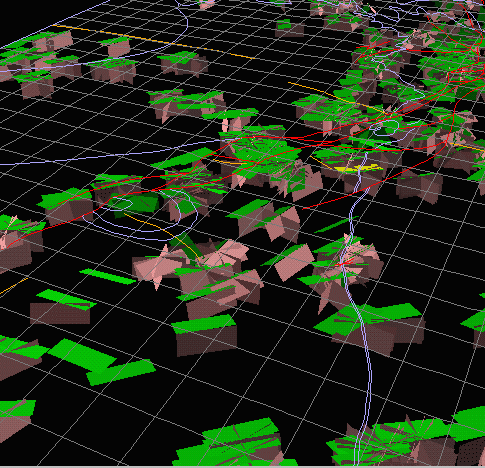DGS00-5 ArcView 3.X Extension for Making 2D and 3D Structural Geologic Shapefiles
GeoStructure3D and GeoStructure2D are ArcView extensions for making 3D or 2D shapefiles of oriented and annotated structural geological symbols.
Abstract
DGS00-5 includes two ArcView 3.x program extensions for creating 3-dimensional (3D) and 2-dimensional (2D) shapefiles of structural geology symbols from tabular data files containing structural measurements, geological variables, and geographical coordinates. These programs assist geologists in the production of digital geological themes and maps by providing the tools to automatically generate oriented structural symbols at any user-specified map length. Map labels for the structural inclination can be autolabeled using standard ArcView program options. The 3D extension (GeoStructure3D.avx) is useful for visualizing 3-dimensional structural relationships using the ArcView 3D analyst program extension. The 3D extension has a program dependency on the ArcView 3D Analyst extension and provides tools for generating 2D symbols for standard map production. The 2D version (GeoStructure2D.avx) is not dependent on the 3D Analyst extension and provides support for map-symbol production only. The user can choose from six 2D map symbols for planes (bedding, foliation, joint, cleavage1, cleavage2, and half plane) or four 2D map symbols for lineations (lineation1, lineation2, lineation3, and slip lineation). Simple rectangular polygons are generated for 3D planar structures, and simple polylines are used for 3D lineations. Three different options are available for specifying structural orientation (Strike, Dip, and Dip Direction; Azimuth and Inclination; and Quadrant). Data files are added to a project as virtual tables (VTab) prior to running the extension. VTab data are delimited text files with a prescribed set of field names for the structural bearing and inclination, the ‘types’ and ‘kinds’ of structures, and lithology and location variables. VTabs also require unique point (station) identification and geographical coordinates (x-coord and y-coord) . Shapefile output includes variables for the station number, azmuthal bearing, inclination, units, and location (domain).

Example image of two 3D fracture themes generated using DGS00-5 ArcView extension. 3D geological features include planes for sedimentary bedding (green), and joints (pink). 2D geological features include line traces of geologic contacts (lt. purple), faults, (red), folds (orange), and a mesh (gray) with cells measuring about 2700 ft on a side.